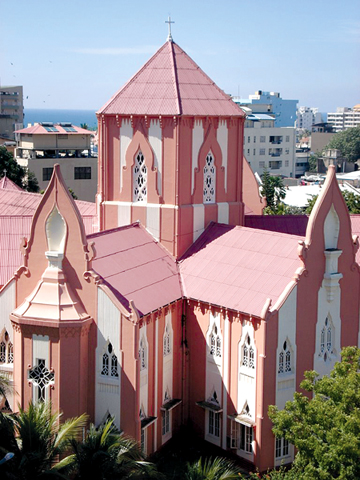|
St. Lawrence Church, Wellawatte:
Magnificently exquisite
 St.
Lawrence Church is an ocean of peace and beauty in the hustle and bustle
that is Wellawatte. Exquisite in its architecture, interior design and
icons, the structure demonstrates the aesthetic sensibilities of its
designer, Rev. Fr. Robert Fernando, the first Parish Priest of St
Lawrence, who laboured for 30 long years to turn design concept into
magnificent reality. St.
Lawrence Church is an ocean of peace and beauty in the hustle and bustle
that is Wellawatte. Exquisite in its architecture, interior design and
icons, the structure demonstrates the aesthetic sensibilities of its
designer, Rev. Fr. Robert Fernando, the first Parish Priest of St
Lawrence, who laboured for 30 long years to turn design concept into
magnificent reality.
St. Lawrence, named after the patron saint of the City of Colombo,
was an ordinary small structure before Fr. Fernando decided it was
inadequate to hold the growing Roman Catholic congregation, and went on
to design and build the unique hexagon shaped building, deemed the most
beautiful church in Sri Lanka .
The main entrance to the Church is from Galle Road, through an avenue
of tall palm trees that invite the visitor to step in under the shade
and keep walking towards the sanctuary ahead.
The Church has five wings to seat the congregation, signifying the
five wounds of Jesus Christ. The seven feet cement crucifix that stands
behind the tabernacle is an amazing work of art.
Flames on the gridiron
The Church is painted in shades of pink and yellow, symbolising the
flames on the gridiron, on which St. Lawrence was burnt alive. History
records St. Lawrence as being a Deacon in Rome, who was responsible for
the wealth of the Church, and that he was burnt alive on a purpose built
gridiron by the Emperor of Rome, furious at St. Lawrence's refusal to
hand over the wealth of the Church. It is said that St Lawrence,
dismissing the Emperor's request, distributed the treasure among the
poor.
|

Panoramio.com |
The entire theme and architecture of the Church reflects the flames
on which St. Lawrence was burnt alive. The design of wheat and grape
wine on the inner walls of the sanctuary and on the communion rails, the
olive branch and the gridiron, the symbol of St Lawrence on the inner
veranda walls and the angel's face on all entrance door frames were the
brainchild of Fr Robert Fernando, who also had an edifice constructed
near the main gate entrance and installed Our Lady of Fatima to protect
the compound.
The interior of the Church is also painted in hues of pink and yellow
and there are many beautiful statues of Mother Mary, Jesus Christ, St.
Joseph, Infant Jesus and St. Lawrence.
The Nave contains the altar where the distribution of Holy Communion
at Mass takes place. The Chancel is decorated with patterns of wheat and
grapes, which symbolises the bread and wine that is transformed at the
Eucharistic celebration into the Body and Blood of Jesus Christ. The
roof of the Chancel has a triangle that symbolises the Holy Trinity -
the Father, Son and Holy Spirit. The walls of the Chancel have patterns
of Passion Flowers and Water Lilies. The Passion Flower symbolises the
Passion of Christ and the Water Lilies symbolize the purity of the
Blessed Virgin Mary.
Side chapels
There are four side chapels inside the Church - the Chapel dedicated
to St. Lawrence, the Chapel dedicated to the miraculous Infant Jesus,
the Chapel dedicated to the Blessed Virgin Mary and the Chapel dedicated
to St. Anthony, the patron of lost articles.
On the wings of the Church are beautiful statues of important saints,
with the walls of the Nave lined with poignant pictures of the Stations
of the Cross. A suffering Jesus Christ rests patiently on the Cross,
while his grieving Mother Mary watches from below and at Jesus Christ's
feet is an anguished Mary Magdalene, who is consumed with sadness.
St. Lawrence Church was ceremonially consecrated on March 6, 1968 by
late His Eminence Cardinal Cooray OMI. Although Fr. Robert, who has been
referred as a human dynamo, is no more, his name is synonymous with the
parish of St Lawrence.
The Feast of St. Lawrence is celebrated annually on 9 August.

Pictures by
Sumanachandra Ariyawansa |

